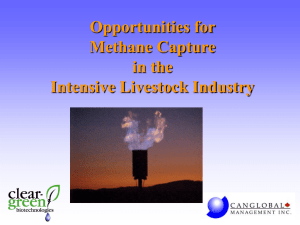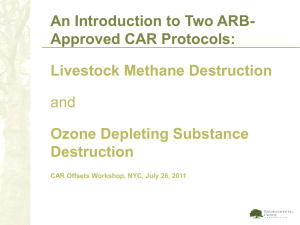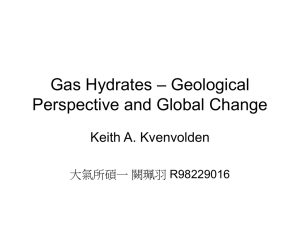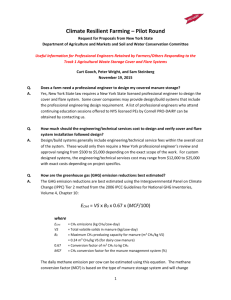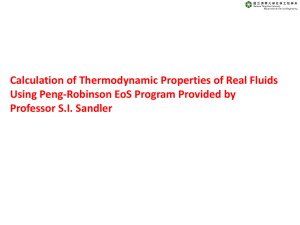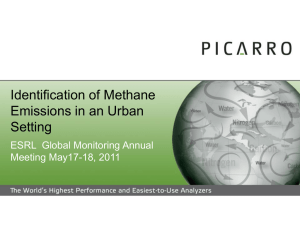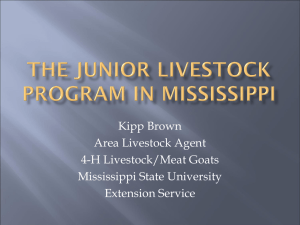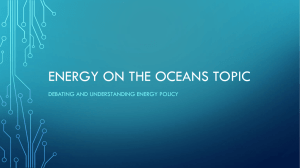Linking renewable energy, organic resource management and
advertisement
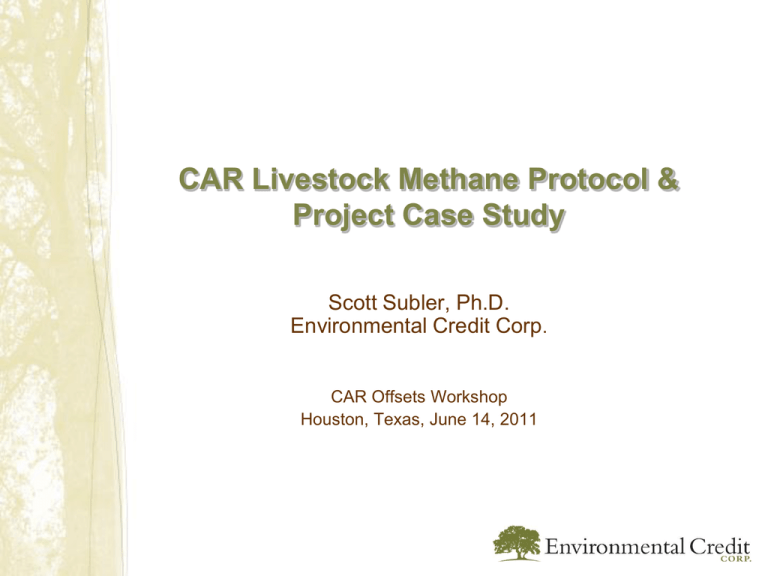
CAR Livestock Methane Protocol & Project Case Study Scott Subler, Ph.D. Environmental Credit Corp. CAR Offsets Workshop Houston, Texas, June 14, 2011 Environmental Credit Corp. • Leading US carbon offset project developer and ”aggregator” • ~ 65 projects listed through programs including the Climate Action Reserve (CAR), the Clean Development Mechanism (CDM), and the Chicago Climate Exchange (CCX) • Project types include: – destruction of ozone depleting substances – agricultural methane destruction – composting – landfill and waste water methane capture – renewable energy production ECC’s Offset Projects in the US ECC ranked as #1 US offset project developer in 2009 (PointCarbon) Livestock methane capture Landfill methane capture Composting Destruction of Ozone Depleting Substances manure lagoon Case Study: Fessenden Family Dairy • • • • King Ferry, New York (Finger Lakes Region) 1,100 dairy cows Liquid manure management (flush system) Open-air anaerobic manure lagoon dairy barns Dairy Farming Manure collection Photos: USEPA AgStar Animal manure storage is a widespread source of methane emissions Odor Greenhouse gases VOC, NH3, H2S, N2O, CO2, CH4 anaerobic decomposition (bacteria) Air Quality Concerns: • Greenhouse gas emissions (Fessenden Farm ~200 metric tons methane/year) • Odor • Ammonia Open-air manure lagoon Simple covers can capture methane from lagoons and reduce GHG emissions Air-tight membrane cover Biogas collection system Generator/flare biogas CH4 anaerobic digestion Benefits: • Reduced GHG emissions (Fessenden Farm > 4,000 metric tons CO2e/year) • Reduced odor • Improved stormwater management • Potential for biogas use (renewable electricity, heat) Covered manure lagoon Lagoon Cover Design & Implementation • • • • • Simple, low-cost technology U.S. supplier, local jobs Rapid installation Reliable operation Farmer friendly Methane Emission Reductions • Established protocols Methane Combustion • Independently audited • Formal registration Renewable Energy Production Fessenden Dairy -- Anaerobic Digestion to Energy 2nd Stage Effluent Storage Manure & Food waste 1st Stage Heated Covered Lagoon Digester Genset & Heat Exchange Anaerobic digesters in US (livestock) Number of operating digesters (Nov. 2010): AgStar Database (129 Dairy) Source: USEPA AgStar Common Technologies for Dairy AD • Ambient Temperature “Lagoon Covers” • Plug Flow/Mixed Plug Flow Photo: RCM International • Complete Mix • Other… Photo: Fair Oaks Farms ECC Lagoon Cover Program • ECC Build/Own/Operate – Permits, insurance, major maintenance – Carbon monitoring, verification, registration • • • Rob Hilarides Lindsay, CA Routine oversight by farmer Farmer compensated with share of carbon credit value Farmer can buy out lagoon cover/biogas collection system to own/operate for a larger share of carbon value Plug Flow Manure Digester Mixed Plug Flow Manure Digester Centralized Complete Mix Digester Huckabay Ridge, Texas Typical Livestock Digester Economics • Capital requirements – High ($1,000 – $1,600) per milk cow – AD systems not always ‘farmer-friendly’ • Electricity prices – Mostly low ($0.04 - $0.06/kWh) • Renewable energy value – Significant in some states ($0.02 - $0.07/kWh) • Carbon prices – Have been significant for some projects; uncertain market • Tipping fees for off-farm organic materials (food waste) – Site specific, but in some cases equal to or greater than electricity revenues • Separated solids value (nutrients, compost, bedding) – Variable; often high value for bedding CAR U.S. Livestock Project Protocol (v3.0) • Project Definition – The installation of a biogas control system (BCS) that captures and destroys methane (CH4) gas from manure treatment and/or storage facilities on livestock operations. • Eligible technologies – Centralized digesters – Co-digestion of organic waste (greenhouse gas [GHG] benefits not quantified for non-manure waste streams) – Methane destruction onsite (enclosed flare, open flare, electricity generation, thermal energy production) – Methane destruction offsite (direct use via pipeline) – Methane destroyed as fuel for vehicles (onsite or offsite) – Biogas destruction in fuel cells CAR Project Eligibility Requirements • Location – U.S., territories, U.S. tribal lands • Start Date – Project must be submitted within six months of becoming operational • Performance Standard – Installation of one of the technologies accepted in the protocol • Legal Requirement Test – Project must not be required by law • Regulatory Compliance – Project must be in compliance with all federal, state and local laws or regulations CAR Project Quantification Methodology • Methane emission reductions relative to ‘Baseline’ – Baseline represents “business as usual” or what would have occurred without the BCS installation – Calculated monthly for each year of the project – For new livestock operations (greenfield sites), baseline is based on prevailing system type for their region, animal type and farm size • Monitoring of methane production, destruction and emissions – Biogas flow and methane concentration – Destruction device operation and efficiency – Project equipment and vehicle emissions • Annual reporting and verification • Crediting Period – Project is eligible to receive credits for 10 years from start date. Project may apply for a second 10-year crediting period Livestock Methane Project Profile Project Duration Long 10 – 30 years Relative Credit Yield Low 1,000 – 25,000 per year Total Available Market Large, stable Thousands of suitable livestock operations; 20+ million tons per year Capital Requirements High Relative to carbon yield Additional Revenues/Benefits Many Renewable energy, RECs, Compost/bedding, Environmental benefits CAR Livestock Methane Projects 140,000 120,000 CRTs 100,000 80,000 60,000 40,000 20,000 0 2007 2008 2009 2010 2011 Vintage CRT Issuances Number Avg. Quantity *As of June 2, 2011 2007 2008 2009 2010 2011 2 7 14 11 0 18,000 4,700 7,600 11,100 0 Livestock Project Issues/Risks • Carbon credit value tends to be small compared to other project revenues and benefits – Carbon credits are an important driver for carbon-specific ‘lagoon cover’ projects – Less important for renewable energy projects (although may ‘tip’ economics favorably) • Carbon credit certification is currently only feasible for very large livestock operations – Relatively small quantity of emission reductions per project means that CAR listing and verification expenses, along with required monitoring and sampling costs, tend to exceed the value of the CRTs for all but the largest farms ARB Implementation of CAR Protocol • Similar in approach and quantification methodologies • Except: 1 CAR CRT is worth only 0.87 ARB offsets? – Reflects project (biogenic) CO2 emissions from combusted methane • Additional costs for conversion of registered CAR CRTs – A “desk review” may be possible for some project verification transitions, but the cost of even a “desk review” is likely to be substantial on a per-credit basis • Future program design changes that could reduce costs – Bundling of projects – CDM-style “small scale” project designation with different requirements and costs – Allowing conservative default factors in place of direct measurements – Use of electrical production data in lieu of gas flows and gas composition Keys to Success • • • • Ownership – 3rd party build, own, operate – Farmer focus on area of expertise: on farm manure management ‘Bundled’ projects – Reduced capital costs – More efficient, coordinated O&M Supplemental feed stocks – Readily available organic waste sources for enhanced performance – Additional revenues from organic waste tipping fees, compost sales Aggressive incentives – New state and federal incentives for renewable energy from dairy digesters provide attractive project economics 27 CONFIDENTIAL ssubler@envcc.com
